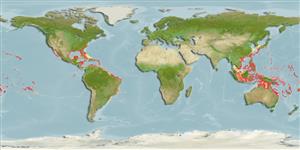Suberites aurantiacus (Duchassaing & Michelotti, 1864)
Lobate sponge| Native range | All suitable habitat | Point map | Year 2050 |

|
| This map was computer-generated and has not yet been reviewed. |
| Suberites aurantiacus AquaMaps Data sources: GBIF OBIS |
Upload your photos
Google image |
No photo available for this species.No drawings available for Suberitidae.
Google image |
No photo available for this species.
Classification / Names Common names | Synonyms | CoL | ITIS | WoRMS
Demospongiae | Suberitida | Suberitidae
Environment: milieu / climate zone / depth range / distribution range Ecology
Sessile; depth range 1 - 50 m (Ref. 108813). Temperate
Distribution Countries | FAO areas | Ecosystems | Occurrences | Introductions
Western Central Atlantic and Central Pacific.
Length at first maturity / Size / Weight / Age
Maturity: Lm ? range ? - ? cm
Short description Morphology
Encrusting to massive growth form, usually with large lobate or digitate projections. External color is usually red or red-orange, but may also be yellow, dark green, greenish purple, or turquoise, internal color is always yellow-ochre. Texture is dense, flexible and rubbery but easy to tear, somewhat similar to cheese. Surface is generally smooth some with occasional goose-bumps. Spicules are straight sharply pointed tylostyles with large variation in size of about 300 to 700 micrometer. Some smaller ones have irregularly shaped or lumpy heads. Ectosome consists of brushes of smaller tylostyles of about 300 micrometers in size.
Combination depth range: min from literature, max from estimate. Occurs in mangrove ponds (Ref. 86789).
Life cycle and mating behavior Maturity | Reproduction | Spawning | Eggs | Fecundity | Larvae
Members of the class Demospongiae are hermaphroditic. Life cycle: The zygote develops into parenchymella larva (free-swimming) before settling down on a substrate where it grows into a young sponge.
Main reference
References | Coordinator | Collaborators
DeFelice, R.C., L.G. Eldredge and J.T. Carlton. 2001. (Ref. 3248)
IUCN Red List Status (Ref. 130435)
CITES status (Ref. 108899)
Not Evaluated
CMS (Ref. 116361)
Not Evaluated
Threat to humans
Harmless
Human uses
| FishSource |
Tools
More information
Internet sources
BHL | BOLD Systems | CISTI | DiscoverLife | FAO(Publication : search) | Fishipedia | GenBank (genome, nucleotide) | GloBI | Gomexsi | Google Books | Google Scholar | Google | PubMed | Tree of Life | Wikipedia (Go, Search) | Zoological Record
Estimates based on models
Preferred temperature
(Ref. 115969): 21.1 - 28.2, mean 26.5 (based on 566 cells).


